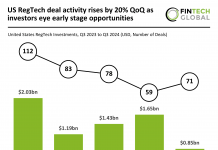Sentinels, which helps detect money laundering in real-time, has released a report outlining why real-time transaction monitoring is the next step for compliance functions.
It stated that digital transformation and disruptive technologies has helped accelerate the development of financial services around the world. Unfortunately, firms are struggling to keep pace with the speed of change.
Many financial products and processes have suddenly been made redundant and firms have needed to evolve. Sentinels offered the example of online banking and payments, which now lets people send money across borders and currencies, to anyone with an internet connection.
While this is great for the average consumer, bad actors are also able to use it for money laundering or other illicit activities.
Sentinels explained that real-time transaction monitoring is becoming essential if firms want to keep up with money laundering. It stated that, “In a matter of hours, a customer can open a bank account online, move funds, and close it down again, well before traditional transaction monitoring processes like batch sorting could identify potential money laundering and alert fraud teams.”
With real-time transaction monitoring, systems can detect potential financial crime instances and take necessary steps to shut it down.
A report from Finbold pegged fines for non-compliance with AML, KYC and data privacy regulations at a total of €12bn in 2020. Regulations are only getting stricter and periodic review processes will become redundant. Real-time transaction monitoring is the only way to stay ahead.
This technology is not exclusively usable for combating money laundering, but also terrorist financing, fraud, drug trafficking, bribery, corruption and identity theft.
Sentinels outlined that real-time transaction monitoring typically uses AI to automatically monitor transactions and other customer activities to identify and prevent financial crimes.
This means it can quickly identify customer activities that don’t match expected or permitted patterns. It can also automate processes and reduce false positives, preventing time being wasted.
Read the report here.
Copyright © 2022 FinTech Global











